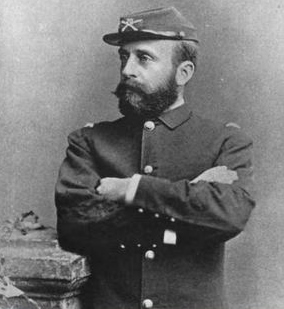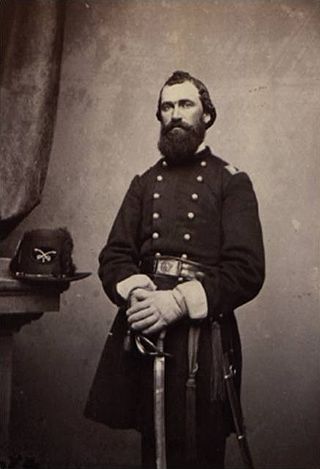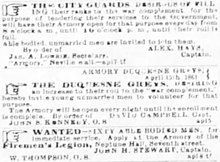
Sylvester Bonnaffon Jr. was a United States soldier who fought with the Union Army during the American Civil War as a first lieutenant with Company G of the 99th Pennsylvania Infantry. He received his nation's highest award for valor, the U.S. Medal of Honor, for his gallantry and leadership against Confederate troops during the Battle of Boydton Plank Road, Virginia on October 27, 1864. That award was conferred on September 29, 1893.

Jacob C. Higgins (1826–1893) was a commander of Pennsylvania troops who participated in both major military conflicts of his time, the Mexican–American War and the American Civil War. Among his Civil War commands, he guided the 125th Pennsylvania Infantry regiment under heavy fire during the Battle of Antietam and likewise during the Battle of Chancellorsville. Following the muster out and return home of the 125th PA, the Gettysburg Campaign sent cavalry under Confederate General John D. Imboden to threaten vital railroad resources at Altoona and iron production facilities in the Juniata River watershed; in response, Emergency Militia was organized by Colonel Higgins and minimized this northwestern incursion.
The 75th Regiment Pennsylvania Volunteer Infantry was a unit of the Union Army during the American Civil War. It was composed almost entirely of German-speaking residents of Philadelphia and newly arrived German immigrants. Total enrollment, over the course of the war, was 1,293 officers and men. The 75th Pennsylvania participated in several major battles including Second Bull Run, Chancellorsville, and Gettysburg. The regiment was transferred to the Western Theater in September, 1863. There, it participated in operations in Tennessee, before it was mustered out of service on September 1, 1865, following the close of the war.
The 2nd Pennsylvania Cavalry was a cavalry regiment that served in the Union Army during the American Civil War.

The 1st Pennsylvania Infantry was an infantry regiment in the Union Army during the American Civil War that served for three months at the beginning of the war.

The 4th Pennsylvania Infantry Regiment, officially known as the 4th Regiment, Pennsylvania Volunteer Infantry, was an infantry regiment of the Union Army in the American Civil War. Formed mostly from a militia unit in Norristown in southeastern Pennsylvania, the regiment enlisted at the beginning of the American Civil War in April 1861 for a three-month period of service under the command of Colonel John F. Hartranft. Logistical difficulties bedeviled the regiment, which served as part of the garrison of Washington, D.C., until late June, when it was sent into Northern Virginia to join in the army of Brigadier General Irvin McDowell.
The 9th Pennsylvania Reserve Regiment also known as the 38th Pennsylvania Volunteer Infantry was an infantry regiment that served in the Union Army as part of the Pennsylvania Reserves infantry division during the American Civil War.
The 191st Pennsylvania Volunteer Infantry was an infantry regiment that served in the Union Army during the American Civil War.

The 215th Regiment Pennsylvania Volunteer Infantry was an infantry regiment of the Union Army in the American Civil War. It was raised in Philadelphia close to the end of the war, and spent most of its slightly more than three months of service guarding Confederate prisoners while garrisoning Fort Delaware.

The 214th Regiment Pennsylvania Volunteer Infantry also knowns as the 8th Union League was an infantry regiment of the Union Army in the American Civil War. It was raised in Philadelphia close to the end of the war, and spent its year of service on guard duty in the Shenandoah Valley and Washington, D.C.

The 213th Regiment Pennsylvania Volunteer Infantry, alternately the 7th Union League Regiment was an infantry regiment of the Union Army in the American Civil War. It was raised in Philadelphia close to the end of the war, and spent its nine months of service on guard duty at Camp Parole and Washington, D.C.

The 211th Regiment Pennsylvania Volunteer Infantry was an infantry regiment of the Union Army in the American Civil War. Raised in western Pennsylvania in September 1864, the regiment initially served with the Army of the James during the Siege of Petersburg, holding trenches at Bermuda Hundred. In late November it transferred to the Army of the Potomac and during the northern hemisphere spring campaign fought in the counterattack during the Battle of Fort Stedman and the Union breakthrough at Petersburg. During the last days of the Appomattox Campaign it guarded trains, and participated in the Grand Review of the Armies following the end of the war before mustering out.

The 197th Regiment Pennsylvania Volunteer Infantry, alternately the 3rd Coal Exchange Regiment was an infantry regiment of the Union Army in the American Civil War. Raised in Philadelphia in mid-1864, the regiment was made up of Hundred Days Men in an effort to augment existing manpower for an all-out push to end the war within 100 days, and spent most of its service guarding Confederate prisoners of war at Rock Island.

The 199th Regiment Pennsylvania Volunteer Infantry, alternately known as the Commercial Regiment, was an infantry regiment of the Union Army in the American Civil War. Raised in Philadelphia in late 1864, the regiment enlisted for one year and was sent to the Army of the James during the Siege of Petersburg. During the Third Battle of Petersburg it assaulted Forts Gregg and Alexander, then pursued the retreating Confederate Army of Northern Virginia, fighting at Rice's Station and Appomattox Court House. Following the Confederate surrender at Appomattox, the regiment moved to Richmond, where it mustered out in late June 1865.

The 201st Regiment Pennsylvania Volunteer Infantry was an infantry regiment of the Union Army in the American Civil War. Raised in the Harrisburg, Pennsylvania area during August 1864, the regiment initially guarded the Manassas Gap Railroad and detachment elements on provost duty in Virginia. The regiment then moved to Alexandria in November, where it performed guard and escort duty. After the end of the war the main body of the regiment garrisoned Fort Delaware before mustering out in mid-1865.

The 206th Regiment Pennsylvania Volunteer Infantry was an infantry regiment of the Union Army in the American Civil War. Raised in the Pittsburgh area in August and September 1864, the regiment was sent to the Army of the James at Bermuda Hundred during the Siege of Petersburg. The regiment remained in camp during the Third Battle of Petersburg and instead marched into Richmond after its evacuation. After serving on provost duty in Virginia, it was mustered out in late June 1865.

The 202nd Regiment Pennsylvania Volunteer Infantry was an infantry regiment of the Union Army in the American Civil War. Raised in the Harrisburg area and the Coal Region in August and September 1864, the regiment was sent to the Manassas Gap Railroad to guard it against the attacks of Confederate partisan rangers led by John Mosby. Following the Union victory at Battle of Cedar Creek, the regiment helped break up the now unneeded railroad and moved to Alexandria to guard the railroad there. After the end of the war, the regiment served in the Coal Region to suppress labor unrest, and was mustered out in mid-1865.

The 207th Regiment Pennsylvania Volunteer Infantry was an infantry regiment of the Union Army in the American Civil War. Raised mostly in northern and central Pennsylvania in mid-1864, the regiment initially served with the Army of the James during the Siege of Petersburg, holding trenches at Bermuda Hundred. In late November it transferred to the Army of the Potomac and during the northern hemisphere spring campaign fought in the counterattack during the Battle of Fort Stedman and the Union breakthrough at Petersburg. During last days of the Appomattox Campaign it guarded the supply line, and participated in the Grand Review of the Armies following the end of the war before mustering out.

Alexander H. Mitchell was a United States military officer who fought with the Union Army during the American Civil War as captain of Company A of the 105th Pennsylvania Infantry. Wounded multiple times in combat during the war, he was awarded the Kearny Cross for his distinguished service in the Battle of Chancellorsville, Virginia in May 1863, and was then also awarded his nation’s highest award for valor, the U.S. Medal of Honor for his capture of a Confederate flag in hand-to-hand combat with the color-bearer of the 18th North Carolina Infantry during the Battle of Spotsylvania Court House on May 12, 1864.
The 25th Pennsylvania Volunteer Infantry was a Three Months' Service infantry regiment which served with the Union Army during the American Civil War. Composed of Pennsylvania First Defenders, the first five companies of men who responded to President Lincoln's call for 75,000 volunteers to defend the national capital in Washington, D.C. following the Fall of Fort Sumter to Confederate States Army troops in mid-April 1861, and five additional companies of early responders who enlisted later in April 1861.








